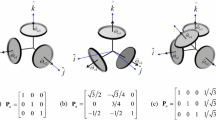Abstract
Formation flying is a novel concept of distributing the functionality of large spacecraft among several smaller, less expensive, cooperative satellites. Some applications require that a controllable satellite keeps relative position and attitude to observe a specific surface of another satellite among the cluster. Specially, the target space vehicle is malfunctioning. The present paper focuses on the problem that how to control a chaser satellite to fly around an out-of-work target satellite closely in earth orbit and to track a specific surface. Relative attitude and first approximate relative orbital dynamics equations are presented. Control strategy is derived based on feedback linearization and Lyapunov theory of stability. Further, considering the uncertainty of inertia, an adaptive control method is developed to obtain the correct inertial ratio. The numerical simulation is given to verify the validity of proposed control scheme.
Similar content being viewed by others
References
Kapila Vicram, Sparks Andrew G, Buffington James M, Yuan Qiguo. Spacecraft formation flying: dynamics and control[C]. In: Proceedings of American Control Conference. San Diego, CA, USA, June, 1999, 6:4137–4141.
Naasz Bo J. Classical element feedback control for spacecraft orbital maneuvers[D]. Ph D Dissertation, the Virginia Polytechnic Institute and State University, 2002.
Hughes Steven P. Formation flying performance measures for Earth-pointing missions[D]. Ph D Dissertation, the Virginia Polytechnic Institute and State University, 1999.
Folta D C, Newman L K, Gardner T. Foundations of formation flying for mission to planet Earth and the new millenium[C]. In: Proceedings of the AIAA/AAS Astrodynamics Conference, AIAA, Reston, VA, USA, 1996, 656–666.
Roux A. Cluster regroups for relaunch[J]. Aerospace America, 1998, 36(8):48–51.
Folkner W M, et al. LISA orbit selection and stability[J]. Classical and Quantum Gravity, 1997, 14(6):1405–1410.
Koss J, Pohlig S, Trichel M, Jeffrey W. Precision radar surveillance and mapping with discoverer II[C]. In: Proceedings of the AIAA Space Technology Conference and Exposition, Albuquerque, NM, USA, 1999, AIAA 99-4570.
Li Junfeng, Meng Xin, Gao Yunfeng, et al. Study on relative orbital configuration in satellite formation flying[J]. Acta Mechanica Sinica, 2005, 21(1):87–94.
Atkins E, Pennecot Y. Autonomous satellite formation assembly and reconfiguration with gravity fields[J]. IEEE, 2002, 296(2):783–796.
Beard R, Stirling W, Frost R. A hierarchical coordination scheme for satellite formation initialization[C]. In: AIAA Guidance, Navigation and Control Conference, Boston, MA, USA, August, 1998, AIAA 98-4225, 677–685.
Vadali S, Vaddi S. Orbit establishment for formation flying satellites[J]. Advances in the Astronautical Sciences, 2000, 105(I):181–194.
Schaub H, Alfriend K T. Impulsive feedback control to establish specific mean orbit elements of spacecraft formations[J]. Journal of Guidance, Control, and Dynamics, 2001, 24(4):739–745.
De Queiroz M S, Kapila V, Yan Q. Adaptive nonlinear control of satellite formation flying[C]. In: Proc AIAA Guidance, Navigation, and Control Conference, Portland, OR, USA, 1999, AIAA 99-4270, 1596–1604.
Roberto Armellin, Massari Mauro, Amalia Ercoli Finzi. Optimal formation flying reconfiguration and station keeping maneuvers using low-thrust propulsion[C]. In: 18th International Symposium on Space Flight Dynamics, Munich, Germany, Oct. 2004.
Clohessy H, Wiltshire R S. Terminal guidance system for satellite rendezvous[J]. Journal of the Aerospace Science. Sep. 1960, 27(9):653–674.
Inalhan G, Tillerson M. How Jonathan P. Relative dynamics and control of spacecraft formations in eccentric orbits[J]. Journal of Guidance Control, and Dynamics, 2002, 25(1):48–59.
Breger Louis, How Jonathan P. GVE-based dynamics and control for formation flying spacecraft[J]. Journal of Guidance, Control, and Dynamics, 2007, 30(2):437–448.
Baoyin Hexi, Li Junfeng, GAO Yunfeng. Dynamical behaviors and relative trajectories of spacecrafts formation flying[J]. J Aerospace Science and Technology, 2002, 4(6):295–301.
Gao Yunfeng, Baoyin Hexi, Li Junfeng. Comparison of two methods in satellite formation flying[J]. Applied Mathematics and Mechanics (English Edition), 2003, 24(8):902–908.
Koon W S, Marsden J E, Masdemont J, Murray R M. J2 dynamics and formation flying[C]. In: Proceedings of AIAA Guidance, Navigation, and Control Conference. Montreal, Canada, August, 2001, AIAA 2001-4090.
Wei Kang, Hsi-Han Yeh, Andrew Sparks. Coordinated control of relative attitude for satellite formation[C]. In: AIAA Guidance, Navigation, and Control Conference and Exhibit, Montreal, Canada, 6–9 August 2001, AIAA 2001-4093.
Wei Kang, Andrew Sparks. Coordinated attitude and formation control of multi-satellite systems[C]. In: AIAA Guidance, Navigation, and Control Conference and Exhibit, Monterey, California, USA, August 5–8, 2002, AIAA 2002-4655.
Wei Kang, Hsi-Han Yeh. Co-ordinated attitude control of multisatellite system[J]. International Journal of robust and nonlinear control, 2002, 12(2/3):185–205.
Su Luopeng, Li Junfeng, Gao Yunfeng. Relative attitude control in satellite formation flying[J]. J Tsinghua Univ (Sci & Tech), 2003, 43(5):28–36 (in Chinese).
Zhang Zhiguo, Li Junfen, Baoyin Hexi. Attitude tracking control of satellite formation flying[J]. J Tsinghua Univ (Sci & Tech), 2006, 46(11):31–39 (in Chinese).
Lin Laixing. Dynamics and control of small satellite flying-around space station[J]. Aerospace Control, 1999, 17(3):26–33 (in Chinese).
Hirohisa Kojima. Fly-around motion control based on exact linearization with adaptive law[J]. J Guidance, control and dynamics, 2005, 28(1):167–169.
Merkin David R. Introduction to the theory of stability[M]. New York: Springer, 1996.
Author information
Authors and Affiliations
Corresponding author
Additional information
Communicated by CHEN Li-qun
Project supported by the National Natural Science Foundation of China (No. 10672084) and the Specialized Research Fund for Doctoral Program of Higher Education (No. 20060003097)
Rights and permissions
About this article
Cite this article
Zhang, Zg., Li, Jf. Orbit and attitude control of spacecraft formation flying. Appl. Math. Mech.-Engl. Ed. 29, 43–50 (2008). https://doi.org/10.1007/s10483-008-0106-x
Received:
Revised:
Issue Date:
DOI: https://doi.org/10.1007/s10483-008-0106-x




